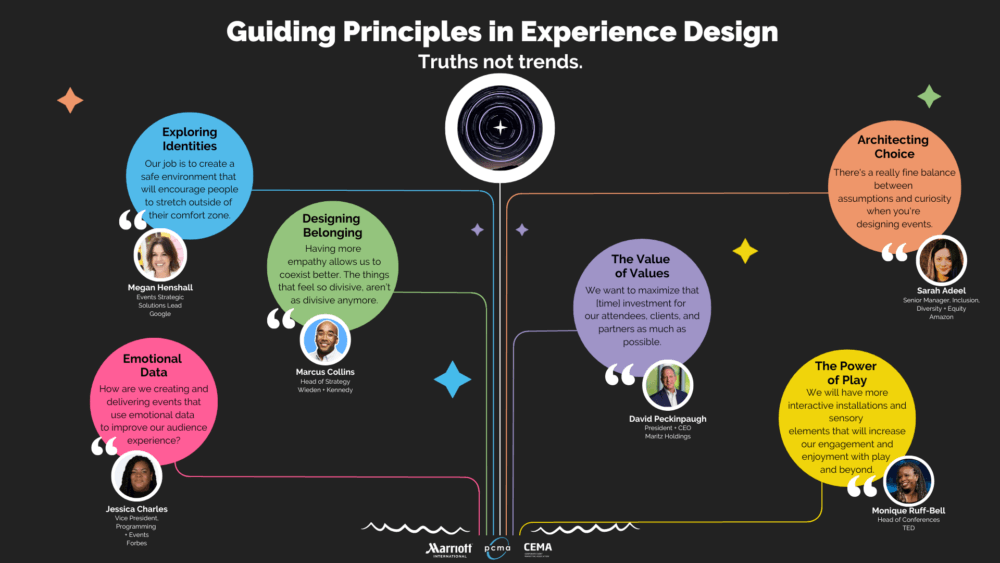The PCMA Foundation partnered with Marriott International and CEMA on a new report, “Guiding Principles in Experience Design: Six Truths for Innovative Event Strategies,” with research conducted and analyzed by creative agency Storycraft Lab, that focuses on constants — truths rather than trends — shaping event design.
Read Convene Editor in Chief Michelle Russell’s summary of the report in this post. You can download a copy by clicking the link below. Download the full report at Six Truths for Innovative Event Strategies.
“Guiding Principles in Experience Design: Six Truths for Innovative Event Strategies” summary
The field of experience design is a nexus for innovation — we learn about our audiences here, test our products, launch our messages, and drive our purpose. The unprecedented disruption wrought by the pandemic presents us with a unique opportunity to learn and shape our future-facing strategies.
The speed of experience innovation is both amazing and difficult to comprehend. The rapid fire of social-media dialogue can be inspiring and dizzying. The pace of technological advancement and market evolution is increasing. There is real fatigue in the overwhelm of constant change. It can be difficult to identify where and how to focus efforts among a clamor of voices and interests.
Trend reports, part of the cyclical release of the industry content machine, only add to this noise. This report offers the industry insights that cut through the noise to help us comprehend, analyze, and assess where and how to drive experience innovation. The truths contained in this report are guiding principles — north stars — that orient us and provide sustained benchmarks that shape our strategies.
 TRUTH 1: Exploring Identities
TRUTH 1: Exploring Identities
Connecting the intersections that make us unique
This truth reflects an increased awareness of the intersectionality of our audiences. As audiences seek to “find their people” and make meaningful connections, the event designer and strategist’s role will include reimagining networking and facilitating connections.
The question for experience designers: How to design experiences that allow attendees to make meaningful connections?
What We Heard
“You have to be okay with being uncomfortable and putting yourself out there — create conversations and camaraderie with people, hear other people’s points of view. We need to be more intentional about creating safe spaces to facilitate this and create a sense of community to enable it.” — Jessica Charles, Vice President, Programming + Events, Forbes
Emerging Themes
- Networked Communities — As people venture on journeys of self-discovery, they consider the multi-faceted aspects of their identity. This increases the many unique groups they can identify or find commonality with.
- The Places That Make Us — The pandemic gave us a new appreciation for local connections, supply chains, resources, and insights. Organizations have found they can learn from local identities as opposed to imposing a central identity.
- Discomfort + Delight — Exposure to different viewpoints and ideas are both the risk and reward when we explore beyond the confines of our comfort zones. Showing audiences how being open to new experiences benefits them in terms of innovation, cross-applications, and new relationships, may get them excited to get out of their comfort zones.
What This Means for Experience Design
“At their core, audiences want to gather to consume content, they want to connect and network. Nothing replaces connection amongst our attendees; the real value in events comes from this aspect. One of the key reasons we invest in events is because of the value they deliver through the face-to-face experience.” — Stuart Frank, Senior Director, Strategic Experiences APAC, Salesforce
Tools and Takeaways
- Co-created Networks — Design ways for people to define and build their own communities and provide space for local, regional, or other identity groups to gather. Meaningful connections happen throughout an event, not just in dedicated networking spaces and activities, so consider how to use interstitial spaces to foster those connections.
- Scales of Intimacy — This could mean smaller gatherings, messaging that incorporates local dialects and customs, or simply a more considered approach to how you present your content via technology.
- Inclusive Invitations — Planners could incorporate psychological safety into their risk-management plans, offer social equity training so that staff can engage with all social identities in the case of conflict, and communicate clear boundaries for participants engaging in discussion.
 TRUTH 2: Architecting Choice
TRUTH 2: Architecting Choice
Engaging audiences as agents of experience
This truth reflects audience desire to have agency over their experiences. At the same time, audiences are looking for support to make clear and informed choices. For experience creators, this represents a shift away from controlling defined outcomes toward a new role as curators of choice, and agents in shaping experience.
The question for experience designers: What’s the right amount of choice at this moment?
What We Heard
“There’s a really fine balance between assumptions and curiosity when you’re designing events because there’s challenge and risk in giving all the authority to the audience. It’s important to find the middle ground between your own assumptions, which are beyond the data bias, and keeping the curiosity alive in your audience.” — Sarah Adeel, Senior Manager, Inclusion, Diversity + Equity, Amazon
Emerging Themes
- Choice — How are we intentional about the choices we offer, looking at the journeys and pathways that those choices represent, and how can we accommodate changes, desires, and needs that evolve over time?
Ron Anderson, cofounder and CEO of Unicorn Group, recommends that planners identify a small and meaningful number of choices that their audience can make at key points along the journey — otherwise, we might run into paralysis of choice.
Kevin Bethune, author of Reimagining Design: Unlocking Strategic Innovation, advocates for the role of thought partners in determining the right places to be giving audiences choices. Bring your audience into the design process in a way that they can help you identify those key points and those key places where choice is necessary and really meaningful to them. It’s important to bring your audience into the mix because the appetite and need for choice varies regionally around the world. - Charting Pathways — As designers, we often design around solving our own problems rather than the problems of the audience. Integrate your audience into the process of charting pathways, scouting ideas, and verifying journeys.
- Accommodating Change — People’s opinions and needs shift and change, so we need to offer flexibility. It’s about designing a journey in which people can try one option, try another option, and come back and re-experience a flow depending on a new perspective or need.
What This Means for Experience Design
“People are becoming more accepting of having diverse choices. People appreciate having the optionality to choose. Especially with in-person event experiences, people are looking for more elevated aspects that make it worth their time.” — Amanda Ma, Founder + CEO, Innovate Marketing Group
Tools and Takeaways
- The Role of Architect — Architecting journeys that are diverse and provide flexibility without overwhelm requires that we consider wayfinding and communication to guide the process of exploration and discovery.
- The Role of Audience — Think about how the audience plays into the process of design and the valuable feedback that they can offer you at the right points along that path. Tools such as audience personas can create distinct, personalized pathways to design around.
- Setting the Space for Success — For neurodivergent audiences, The Neu Project (theneuproject.com) suggests allocating recovery spaces like quiet rooms, creating zones where socializing or interacting is not expected, or setting up more intimate options for networking.
 TRUTH 3: Designing Belonging
TRUTH 3: Designing Belonging
A new strategic goal and driver of intentional design
Belonging has emerged as such a pervasive truth that it underpins the majority of the new principles in design shared in this report. Belonging has turned up as a mission and as a measurement, and it is central to the meaning and even magic of the experiences we create.
The question for experience designers: How might we design journeys that facilitate belonging for everyone?
What We Heard
“Creating a welcoming, belong- ing, inclusive place is difficult, but at the end of the day, we’re still human. Attendees want to know you care about them. They want to know you’re going to help them get their needs met and guide them in a way that helps them find value.” — Janet Sperstad, Faculty Director, Madison Area Technical College
Emerging Themes
- Defining Belonging — Belonging stops us from reducing DEI to simple metrics by requiring that we examine the extent to which these practices produce meaningful results.
- Authentic Dialogue — People want to know that you care and that they matter and their needs are considered. But it needs to go one step further than that. The audience needs to be willing to share what belonging means to them, and we must be willing to listen and hear the opinions of others without judgment.
What This Means for Experience Design
“Realizing that everyone is human creates a larger sense of empathy in people. The experience of trauma from the pandemic almost mandated that we all find our communities and get in touch with empathy; it is increasingly important to seek intersectionality and connect with others to break patterns of exclusion.” — Karen Robinovitz, Co-founder, Sloomoo
Tools and Takeaways
- Begin With Dialogue — Engage your audience in dialogue at the beginning of the design process, using quizzes, focus groups, or interview conversations to understand varied preferences and needs.
- Be Curious + Proactive — Be deeply curious when considering people with disabilities and non-typical conditions and test what it could mean to accommodate these needs.
 TRUTH 4: The Value of Values
TRUTH 4: The Value of Values
Understanding the ROI criteria that produce audience participation
Audiences are looking for experiences that provide value beyond the dollar, and design choices like sustainability, venue selection, diversity, hybrid channels, communities, time, and uniqueness are all elements that make up the value of an investment for our audiences.
The question for experience designers: How might we adjust our communication to convey all the values an experience provides?
What We Heard
“People are much more disciplined and focused on how they will spend their time, and they’re invested in getting the best experience for themselves. We want to maximize that investment for our attendees, clients, and partners as much as possible.” — David Peckinpaugh, President + CEO, Maritz Holdings
Emerging Themes
- Needs + Values — According to Accenture, two-thirds of consumers have cut down on at least one external entertainment activity, choosing instead to stay indoors. These choices are being made around the value between staying in, going out, and connecting with others at an event or virtually. Audiences are asking how experiences are designed to meet their needs and the needs of society.
- Actions + Activism — Audiences are looking for brands that demonstrate ethical behavior before they agree to dedicate their time and involvement with that brand. Individuals are aware of the weight and the impact that their participation can generate at the events that they do attend and increasingly aware of the power of voting with their feet.
What This Means for Experience Design
“The awareness of how valuable people are, from companies to events and audiences, that’s what matters. Knowledge can be transferred in lots of different ways, but relationships are forged in person.” — Anna Abdelnoor, Co-founder + CEO, Isla
Tools and Takeaways
- Knowing What Matters — Start with your audience’s values and communicate and demonstrate how you will walk the talk.
- Showing You Care — Ensure that you are pointing to real-life examples of how your organization and your event lives your values by highlighting partner- ships or employee volunteerism.
- New Value Propositions — Distinct offerings continue to be needed to meet audience values. For the time-conscious, the virtual-hybrid experience will remain essential in order to be connected to their communities wherever they are. Articulate value propositions that address time, community access, and demonstrate the ROI for the audience in terms of advocacy.
 TRUTH 5: Emotional Data
TRUTH 5: Emotional Data
Assessing the feelings that generate behavior and action
This truth reflects the considerable shift in how business regards emotion. Once something that was seen to limit sound logic, emotions are now seen as a key to driving loyalty and important decision making. For experience designers and strategists, there is much to be discovered about how we make use of this data, measure it consistently, when, where, and how it is collected, and what we can glean from its analysis.
The decisions we make as attendees, as participants, as community members, as consumers — whatever role we’re playing, those are driven by emotion. That means that event designers have to let go a little bit of our business outcomes as the primary concern. Instead, consider how we talk to our audiences and engage with our audiences emotionally.
The question for experience designers: How can we best assess the emotional state of our participants?
What We Heard
“Most surveys do not measure how people feel. Rather, they measure how people feel about the choices you gave them, resulting in inherent confirmation bias.” — Chris Laping, author of People Before Things
Emerging Themes
- Emotions Mean Business — It’s not emotion or business, it’s emotion and business. Ultimately, emotional data is a new and emerging form of data that can help us better gauge and pre- dict what returns might be.
- The Feedback Loop — Finding new, more strategic ways to return data to the audience, clarifying how and what it is used for, and making people comfortable with sharing emotional states are the way to move forward.
What This Means for Experience Design
“It doesn’t stop at measurement: We must use the data we collect to inform our practice. How are we creating and delivering events that use emotional data to improve our audience experience?” — Jessica Charles, Vice President, Programming + Events, Forbes
Tools and Takeaways
- It’s Still ROI — At the Google Xi Days event, the ROE (Return on Emotion) survey was conducted on the final day and measured via numeric scale how the attendees felt about five key emotions: hopeful, adventurous, accepted, active, and motivated. This approach provides an alternate metric to NPS (Net Promoter Score — i.e., how likely would you be to recommend this event?).
- No More Post-Event Surveys — At Xi Days, Meeting Pulse used sentiment polling at every activation, which employed a quick and simple system of emojis and keywords to collect responses.
 TRUTH 6: The Power of Play
TRUTH 6: The Power of Play
Infusing cultures of collaboration and innovation
This truth is a compelling design mindset that benefits wellness, creativity, and productivity.
Play connects function and experience, helps to catalyze content, build teams, define cultures, introduce new ideas, synthesize learnings, and spark joy. Audiences want to get hands-on and be free to tinker as they make sense of new concepts.
Designers will create play-first spaces that celebrate testing and experimentation.
The question for experience designers: We know the value of play being infused as a mindset throughout the fabric of our experience. How can we design those spaces where play and joy can thrive?
What We Heard
“Storytelling and narrative is the way we make sense of the world, and that’s one key way that we can help people make sense of all these multiple tools. Breaking something apart and putting it back together — that’s a shortcut for understanding and making sense of it. Play is interesting, because it solves many of its own problems — we put the parts together, blow them up, and put them back together in new ways.” — Ryan Howard, Technical Program Manager, Experience Design, Google
Emerging Themes
- Play and Productivity — We can drive experience and technology forward by creating a new playscape process — one that supports creativity through play, mindfulness, and imagination.
- Unprogrammed Play — When playing, people leave their ego at the door, which allows them to get radical and creative. Play should not be confused with games, however. Competition changes the nature of play and produces the opposite of innovation, experimentation, and collaboration.
- New Tools for Collaboration — One of the major tools that has emerged for us to experiment with in terms of play is AI. Developments in AI are opening new avenues for experimenting and playing with new tech tools that can facilitate communication and connection. Filmmakers, for example, are experimenting with AI to detect the emotions of the audience and use that information to reconfigure the narrative in real time, creating an immersive experience, according to an article in “The Conversation.”
What This Means for Experience Design
“Play is a lifestyle, it doesn’t have to be necessarily chess or sports, it’s a mindset. Infusing play into events, whatever that looks like, has to be fundamental. It can’t be a luxury or something that we do occasionally, it has to be infused into the fabric of the experience.” — Zach Fisher, Founder, Kinflow
Tools and Takeaways
- Play Place-Making — Creating dedicated spaces that are flexible and without too many rules will encourage play.
- Positive Resonance — Those who have seen the effect of having shelter dogs available for petting and adoption at a space at an event see that the act of play can benefit everyone, including observers, not just the individual at play.
- AI, a Creative Co-Pilot — Carve out a role for AI on your team, or find a space for AI to play with your meeting participants, and for them to play with it — celebrate the messy and the authentic product as a co-created art piece.
ABOUT THIS REPORT
Our first phase of research resulted in more than 60 one-on-one interviews, generating approximately 2,000 unique comments. We asked our experts to use change as a lens to sense areas of focus and progress, and to forecast the drivers and frameworks that will guide experience design in the coming years.
We brought experts together, in person and remotely, for focused discussion. These global roundtables examined the tenets that emerged from the interviews and assessed how these trends are being integrated and planned for in practice.
Our content partner, Google Xi (Google Experience Institute), shared case studies from its Xi Days event, which featured new event formats and experimentation in content delivery, for this report.
To diversify our data, we are now calling for your help to bring this grand experiment to a wider audience, by seeking organizations to test a truth over the course of 2023 and share their findings. Which truth will you test in 2023, and beyond? The results of testing and case studies will be included in a final white paper, to be released in January 2024. For more information, email [email protected].
This report is the latest in a series of insightful industry studies started in 2015, thanks to a partnership between PCMA and Marriott International.

